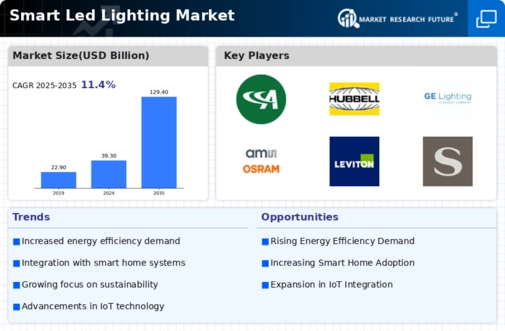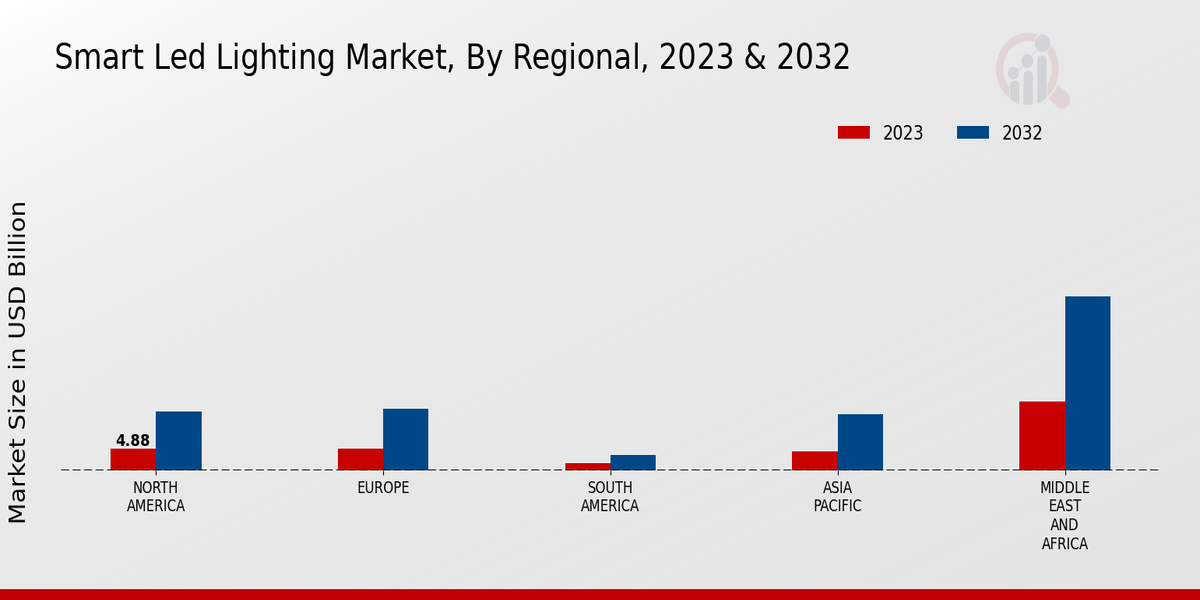Market Growth Projections
The Global Smart Led Lighting Market Industry is poised for substantial growth in the coming years. With a projected market value of 39.3 USD Billion in 2024, the industry is anticipated to expand significantly, reaching 129.4 USD Billion by 2035. This growth trajectory is underpinned by a compound annual growth rate (CAGR) of 11.45% from 2025 to 2035. Such projections indicate a robust demand for smart LED lighting solutions, driven by factors such as energy efficiency, technological advancements, and urbanization. The market's expansion reflects a broader shift towards sustainable and intelligent lighting systems across various applications.
Growing Demand for Energy Efficiency
The Global Smart Led Lighting Market Industry is experiencing a surge in demand for energy-efficient lighting solutions. As energy costs continue to rise, consumers and businesses alike are increasingly seeking ways to reduce their energy consumption. Smart LED lighting systems, which offer features such as dimming and scheduling, allow users to optimize their energy use. In 2024, the market is projected to reach 39.3 USD Billion, reflecting a growing awareness of sustainability and energy savings. This trend is likely to continue, as energy efficiency regulations become more stringent globally, further driving the adoption of smart LED technologies.
Government Initiatives and Regulations
Government policies and regulations play a pivotal role in shaping the Global Smart Led Lighting Market Industry. Many countries are implementing stringent energy efficiency standards and providing incentives for the adoption of smart lighting technologies. These initiatives aim to reduce carbon emissions and promote sustainable practices. For example, various governments are offering tax rebates and subsidies for businesses and homeowners who invest in energy-efficient lighting solutions. Such supportive measures are likely to accelerate the transition to smart LED lighting, fostering market growth. As regulations evolve, the demand for compliant lighting solutions will further drive the industry.
Rising Awareness of Environmental Sustainability
The growing awareness of environmental sustainability is influencing consumer preferences in the Global Smart Led Lighting Market Industry. As individuals and organizations become more conscious of their ecological footprint, there is a marked shift towards eco-friendly lighting options. Smart LED lights, which consume less energy and have a longer lifespan compared to traditional lighting, are increasingly favored. This trend is reflected in the market's projected growth, as consumers seek products that align with their sustainability goals. The emphasis on reducing waste and energy consumption is expected to bolster the adoption of smart LED technologies in various sectors.
Technological Advancements in Lighting Solutions
Technological innovations are propelling the Global Smart Led Lighting Market Industry forward. Advances in IoT and smart home technologies have enabled the development of sophisticated lighting systems that can be controlled remotely via smartphones or voice-activated devices. These systems not only enhance user convenience but also improve energy management. The integration of sensors and automation features allows for adaptive lighting that responds to environmental changes. As these technologies evolve, they are expected to attract more consumers, contributing to the market's growth. The projected CAGR of 11.45% from 2025 to 2035 indicates a robust future for smart LED lighting solutions.
Increasing Urbanization and Smart City Initiatives
Urbanization is a significant driver of the Global Smart Led Lighting Market Industry. As cities expand, the demand for efficient and sustainable lighting solutions becomes critical. Smart city initiatives are increasingly incorporating smart LED lighting to enhance public safety, reduce energy consumption, and improve the quality of urban life. For instance, cities are deploying smart streetlights that adjust brightness based on pedestrian and vehicular traffic. This not only conserves energy but also reduces light pollution. The market is expected to grow substantially, reaching 129.4 USD Billion by 2035, as urban areas continue to adopt these innovative lighting solutions.
























Leave a Comment